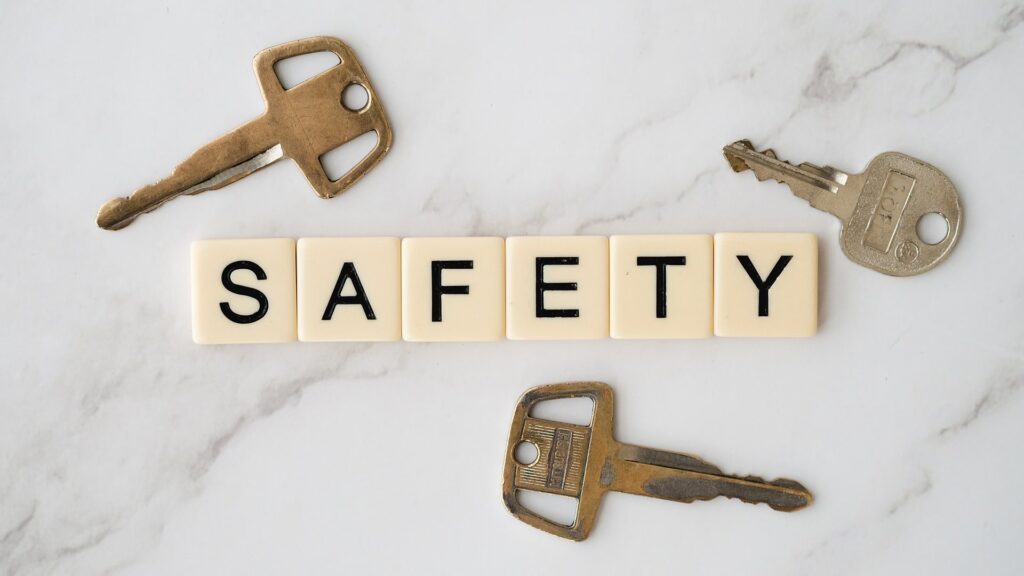Maintaining a lush, green lawn is a point of pride for many homeowners. However, lawn care safety should always be the top priority when tending to your outdoor space. From operating power equipment to handling chemicals, yard work comes with its fair share of risks. This comprehensive guide will walk you through essential outdoor safety tips to ensure you can enjoy a beautiful lawn without compromising your well-being.
Introduction: Why Lawn Care Safety is Crucial for Every Homeowner
Lawn maintenance is more than just aesthetic upkeep; it’s a responsibility that requires careful consideration of safety measures. According to the U.S. Consumer Product Safety Commission, over 200,000 people are treated for lawn and garden tool-related injuries each year. This staggering statistic underscores the importance of yard work safety.
The risks associated with lawn care are diverse and sometimes unexpected. From the obvious dangers of sharp blades and powerful machinery to the less apparent hazards like sun exposure and repetitive motion injuries, there’s a lot to consider. Moreover, the chemicals used in lawn care, if mishandled, can pose serious health risks to humans, pets, and the environment.
Whether you’re a DIY enthusiast or considering professional lawn care, understanding the basics of lawn care safety is essential. It’s not just about protecting yourself, but also your family, pets, and even your neighbors. Let’s dive into the key areas where precautions can make all the difference.
Gearing Up: Essential Safety Equipment for Yard Work

Before you start any lawn care task, it’s crucial to have the right protective gear. Here’s a detailed checklist of essential safety equipment:
- Safety goggles or glasses: Protect your eyes from flying debris, dust, and chemical splashes. Look for impact-resistant lenses with side shields for maximum protection.
- Ear protection: Choose between earplugs or earmuffs. For prolonged exposure to loud equipment, consider using both for enhanced protection against noise-induced hearing loss.
- Work gloves: Select gloves based on the task. Leather gloves are great for general yard work, while chemical-resistant gloves are essential for handling fertilizers and pesticides.
- Steel-toed boots or sturdy closed-toe shoes: These protect your feet from falling objects and provide better traction on uneven surfaces.
- Long pants and long-sleeved shirts: Opt for breathable, durable fabrics that protect your skin from sun, insects, and abrasions.
- Dust mask or respirator: Use a dust mask for general yard work and a respirator when handling chemicals or working in dusty conditions.
- Sun protection: Don’t forget a wide-brimmed hat and sunscreen to protect against harmful UV rays.
Investing in high-quality safety gear for yard work not only protects you from immediate injuries but also helps prevent long-term health issues such as hearing loss or respiratory problems. Remember, the cost of good safety equipment is always less than the potential medical bills from an injury.
Power Equipment Safety: Mastering Your Lawn Care Arsenal
Lawn Mower Safety: Cutting Grass, Not Corners
Lawn mower safety is paramount when it comes to yard work. Here are some crucial tips:
- Read the manual thoroughly before operating any new mower. Each model may have specific safety features and operating instructions.
- Clear the lawn of debris, rocks, and toys before mowing. A pre-mowing inspection can prevent dangerous projectiles.
- Never mow wet grass, as it can cause slipping and clog the mower, leading to potential hazards.
- Keep children and pets indoors while mowing. The noise can be damaging to their hearing, and there’s always a risk of flying debris.
- Always push the mower forward, never pull it backward. This reduces the risk of foot injuries.
- When refueling, allow the engine to cool first to prevent fires. Never smoke while refueling.
- For slope mowing, mow across the face of slopes, never up and down. This maintains better control and reduces the risk of rollovers with ride-on mowers.
- Wear appropriate footwear – no sandals or bare feet, even with a push mower.
- Never leave a running mower unattended, even for a moment.
- Clean your mower after each use, but disconnect the spark plug first to prevent accidental starts.
String Trimmer Techniques: Precision Without Peril
String trimmers, often called weed eaters, require careful handling:
- Wear protective eyewear and long pants to guard against flying debris. Small stones can become dangerous projectiles.
- Maintain a safe distance from others while operating. A good rule of thumb is to keep people at least 50 feet away.
- Use the proper cutting techniques to avoid damaging trees or structures. Avoid hitting the string against hard surfaces, which can cause it to break and fly off.
- Check the cutting head regularly for cracks or damage. Replace if necessary to prevent parts from breaking off during use.
- For gas-powered trimmers, mix fuel properly and store it safely in an approved container.
- Electric trimmers require careful cord management. Always keep the cord behind you and be aware of its location to avoid tripping or cutting it.
Hedge Clipper Handling: Shaping Shrubs Safely
When using hedge clippers:
- Ensure a stable footing before starting. Use a sturdy ladder if necessary, following proper ladder safety protocols.
- Keep both hands on the handles for better control. Never operate a hedge clipper one-handed.
- Be aware of power cords if using electric clippers. Keep them clear of your working area to prevent accidental cutting.
- Wear thick gloves to protect your hands from blisters and potential cuts.
- Avoid overreaching, which can lead to loss of balance and falls.
- Clean and oil the blades after each use to maintain their sharpness and efficiency.
Chemical Caution: Safe Handling of Lawn Care Products

Proper handling of fertilizers, pesticides, and herbicides is crucial for both personal and environmental safety:
- Always read and follow label instructions meticulously. The label is the law when it comes to chemical usage.
- Store chemicals in their original containers, out of reach of children and pets. Never transfer chemicals to food or beverage containers.
- Wear appropriate protective gear when applying chemicals. This typically includes gloves, long sleeves, pants, closed-toe shoes, and eye protection.
- Avoid application on windy days to prevent drift. Early morning or late evening are often the best times for chemical application.
- Calibrate sprayers properly to avoid over-application, which can harm your lawn and the environment.
- Clean up spills immediately, following the manufacturer’s instructions for safe disposal.
- Consider eco-friendly alternatives for a safer lawn. Integrated Pest Management (IPM) techniques can reduce the need for chemical interventions.
- Keep a log of chemical applications, including dates, products used, and areas treated.
Eco-Friendly Alternatives
For those interested in green smart gardening, consider these alternatives:
- Compost instead of chemical fertilizers
- Use beneficial insects to control pests
- Plant native species that are naturally resistant to local pests and diseases
- Use manual weeding techniques or organic herbicides
Electrical Safety in the Yard: Powering Your Tools Responsibly
Electricity safety is often overlooked in yard work but is critical for preventing accidents:
- Inspect extension cords before each use for frays or exposed wires. Replace damaged cords immediately.
- Use outdoor-rated extension cords for all yard work. These are designed to withstand moisture and temperature changes.
- Keep cords away from water and sharp edges. Avoid running cords through puddles or across areas where they might be cut by lawn equipment.
- Unplug tools when not in use and during maintenance. Never yank the cord to unplug a tool; grasp the plug itself.
- Use Ground Fault Circuit Interrupter (GFCI) outlets for all outdoor electrical needs. These can prevent electrocution by quickly shutting off power if a fault is detected.
- Be aware of overhead power lines when using tall tools or ladders. Maintain a distance of at least 10 feet from all power lines.
- Store electric tools in a dry place. Moisture can damage tools and create electrical hazards.
- Never use electric tools in the rain or on wet surfaces.
Family-Friendly Lawn Care: Keeping Kids and Pets Safe
Child supervision during yard work is non-negotiable. Here are some tips for safety precautions around children:
- Establish a “kid-free zone” during active yard work. Make it clear and enforce it consistently.
- Teach children about the dangers of lawn care equipment. Explain why they shouldn’t approach running machinery.
- Store tools and chemicals in locked areas inaccessible to children. Use child-proof locks on storage sheds and cabinets.
- Never allow children to ride on lap mowers, even with an adult. Many tragic accidents have occurred this way.
- Remove toys from the yard before mowing to prevent them from becoming projectiles.
- Set a good example by always following safety procedures yourself.
For pet owners:
- Keep pets indoors during mowing and chemical applications. Wait until treated areas are dry before allowing pets back.
- Be aware of plants that may be toxic to animals. Common lawn plants like lilies, azaleas, and certain ferns can be harmful if ingested.
- Clean up and store all tools immediately after use. Curious pets might investigate tools left out.
- Check your yard regularly for wild animal burrows or nests. These can be hazardous to pets and humans alike.
- Consider creating a separate, enclosed area for pets to enjoy outdoor time safely during yard work.
Landscaping Logistics: Beyond Basic Lawn Maintenance
Safe Tree Pruning and Hedge Trimming
When tackling larger landscaping tasks:
- Use proper ladder safety tips, ensuring stability before climbing. Place ladders on level ground and have a spotter when possible.
- Avoid pruning near power lines; call professionals for such tasks. Even branches that don’t touch power lines can conduct electricity when wet.
- Wear cut-resistant gloves and eye protection when using pruning tools. Flying wood chips and sawdust can cause serious eye injuries.
- Use the three-cut technique for large branches to prevent bark tearing:
- Make a small notch on the underside of the branch
- Make a second cut from the top, slightly further out on the branch
- Make the final cut close to the trunk, outside the branch collar
- Keep pruning tools sharp. Dull tools require more force, increasing the risk of injury.
- Be aware of the weight and fall path of branches before cutting. Plan your cuts to avoid property damage or personal injury.
The Importance of Calling Before You Dig
Before any digging project:
- Call 811 to have underground utilities marked. This free service can prevent dangerous and costly accidents.
- Wait the required time before digging to ensure all lines are identified. This is typically 48 to 72 hours.
- Hand-dig around marked areas to avoid damaging utilities. Use caution within 18 inches on either side of marked lines.
- Be aware that private utility lines (like those to outbuildings or irrigation systems) may not be marked by the 811 service.
- If you accidentally hit a line, evacuate the area immediately and call the appropriate utility company.
Timing is Everything: Scheduling Smart for Safer Yard Work

Proper timing can significantly enhance yard work safety:
| Time of Day | Benefits | Considerations |
|---|---|---|
| Early Morning (6-10 AM) | Cooler temperatures, less sun exposure | Dew may make grass slippery |
| Late Afternoon (4-7 PM) | Cooler than midday, grass is dry | Be mindful of fading daylight |
| Avoid Midday (11 AM-3 PM) | Reduces risk of heat-related illness | Highest UV exposure, hottest part of the day |
Consider seasonal factors as well:
- Spring: Be cautious of wet ground and new growth. Watch for emerging plants and wildlife.
- Summer: Take frequent breaks to avoid heat exhaustion. Work in shorter sessions and stay hydrated.
- Fall: Watch for fallen leaves that may hide hazards. Be prepared for rapidly changing weather conditions.
- Winter: Be aware of ice and frozen ground when applicable. Limit outdoor work to warmer days when possible.
Scheduling Around Allergies
For those with allergies, timing is crucial:
- Check pollen forecasts and plan yard work for low-pollen days.
- Avoid working outdoors on windy days when pollen is more likely to be airborne.
- Consider wearing a pollen mask during high-pollen seasons.
- Take allergy medication before starting yard work, not after symptoms begin.
Body-Smart Lawn Care: Protecting Yourself from Strain and Pests
Practicing responsible behavior in lawn care includes taking care of your body:
- Use proper lifting techniques when handling heavy equipment or materials:
- Bend at the knees, not the waist
- Keep the load close to your body
- Avoid twisting while lifting
- Take frequent breaks and stay hydrated:
- Drink water before you feel thirsty
- Take a 10-15 minute break every hour
- Find shade during breaks to cool down
- Apply sunscreen and wear a wide-brimmed hat for sun protection:
- Use a broad-spectrum sunscreen with at least SPF 30
- Reapply sunscreen every 2 hours or after sweating
- Consider UV-protective clothing for extended outdoor work
- Use insect repellent to guard against ticks and mosquitoes:
- Apply repellent to exposed skin and clothing
- Check for ticks after working in grassy or wooded areas
- Consider treating work clothes with permethrin for added protection
- Practice good ergonomics:
- Use tools with comfortable grips and appropriate handle lengths
- Alternate between tasks to avoid repetitive strain
- Maintain good posture and avoid overreaching
- Be aware of your physical limitations:
- Don’t push yourself beyond your fitness level
- Listen to your body and stop if you experience pain or dizziness
- Consider hiring professionals for tasks beyond your capabilities
Tool Storage and Maintenance: A Place for Everything
Proper tool storage and maintenance are key to lawn care safety:
- Clean tools after each use to prevent rust and ensure proper function. Use a wire brush for metal parts and sanitize with a diluted bleach solution to prevent disease spread.
- Store tools in a dry, locked area away from children and pets. Use wall-mounted racks or pegboards to keep tools organized and off the ground.
- Regularly inspect tools for damage and replace as necessary. Look for cracks, loose parts, or signs of wear.
- Keep sharp tools sheathed when not in use. Consider using blade guards for extra protection.
- Maintain power tools according to manufacturer instructions:
- Change oil and filters as recommended
- Sharpen blades regularly
- Check and replace spark plugs as needed
- Create a maintenance schedule for each tool and keep records of repairs and replacements.
- Store fuel in approved containers away from living areas. Use fuel stabilizers for gas that will be stored for extended periods.
- Organize your storage area with safety in mind:
- Keep heavy items at waist level to avoid strain
- Store chemicals on lower shelves to prevent spills
- Use clear labels on all storage containers
Emergency Preparedness: When Yard Work Goes Wrong
Despite best precautions, accidents can happen. Be prepared by:
- Keeping a well-stocked first aid kit easily accessible. Include items specific to yard work injuries like eye wash and burn gel.
- Learning basic first aid for common injuries like cuts, sprains, and heat exhaustion. Consider taking a first aid course.
- Knowing when to seek professional medical help. Signs that require immediate attention include:
- Deep cuts or puncture wounds
- Signs of infection (redness, swelling, warmth)
- Difficulty breathing or chest pain
- Severe allergic reactions
- Head injuries or loss of consciousness
- Having emergency contact numbers readily available. Create a list including:
- Local emergency services
- Poison control center
- Your primary care physician
- A trusted neighbor or family member
- Familiarizing yourself with the location and proper use of fire extinguishers.
- Considering a basic emergency kit for outdoor work, including:
- Bottled water
- Non-perishable snacks
- Flashlight with extra batteries
- Weather radio
- Basic tools for equipment repair
Conclusion: Cultivating a Culture of Safety in Lawn Care
By incorporating these lawn care safety tips into your routine, you can significantly reduce the risk of injury while maintaining a beautiful yard. Remember, safety precautions are not just guidelines—they’re essential practices that protect you and your loved ones.
Whether you’re assessing your lawn’s health, deciding between DIY and professional lawn care, or simply performing basic maintenance, always prioritize safety. With the right approach, you can enjoy the fruits of your labor without compromising your well-being.
Lastly, remember that a truly beautiful lawn is one that’s maintained safely and sustainably. By fostering a culture of safety in your lawn care routine, you’re not just maintaining a yard—you’re nurturing a safe haven for your family to enjoy for years to come. Practice responsible behavior, stay informed about lawn care basics, and always prioritize the well-being of yourself and those around you. With these principles in mind, you can create and maintain a stunning outdoor space that’s as safe as it is beautiful.


